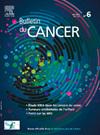Correlation between HPV-16 integration status and cervical intraepithelial neoplasia and cervical cancer in patients infected with HIV
IF 1.1
4区 医学
Q4 ONCOLOGY
引用次数: 0
Abstract
Background
This study aimed to explore the mechanism by which HIV infection promotes cervical cancer and precancerous lesions.
Methods
This was a retrospective observational study including 96 patients with high-risk HPV-16 infection who underwent cervical biopsy, cervical conization, or hysterectomy. Among them, 43 patients were diagnosed with both HIV and cervical cancer or precancerous lesions. High-risk HPV infection (HPV16+) positive samples were collected, and total RNA was extracted and amplified by fluorescence quantitative PCR. The expression of HPV E2 and E6 in cervical tissues of HIV-infected and non-HIV-infected patients with high-risk HPV was determined.
Results
As the degree of cervical tissue lesions increased, the proportions of integrated HPV-16 increased significantly within both HIV-negative (P = 0.008) and HIV-positive groups (P = 0.027). In comparison to the HIV-positive group, although the HIV-negative group had a higher proportion of free type HPV-16 infection (64.3% vs. 35.7%) and a lower proportion of integrated type infection (41.7% vs. 58.3%), the differences were not statistically significant (P = 0.117). The lower the CD4+ T lymphocyte level, the greater the possibility of HPV-16 integrated infection.
Conclusions
Patients with HIV and HPV-16 infection exhibit a significantly higher rate of integrated HPV-16 infection, which is closely linked to HIV-induced immunosuppression, particularly the depletion of CD4+ T lymphocytes. This integration accelerates the progression of cervical lesions, increasing the risk of developing high-grade cervical intraepithelial neoplasia or cervical cancer. These findings underscore the need for targeted screening and therapeutic strategies in HIV-positive women to prevent HPV-related malignancies.
艾滋病病毒感染者的 HPV-16 整合状态与宫颈上皮内瘤变和宫颈癌之间的相关性。
背景:本研究旨在探讨HIV感染促进宫颈癌和癌前病变的机制。方法:这是一项回顾性观察性研究,包括96例高危HPV-16感染患者,他们接受了宫颈活检、宫颈锥切术或子宫切除术。其中43例患者同时被诊断为HIV和宫颈癌或癌前病变。采集高危HPV感染(HPV16+)阳性样本,提取总RNA,荧光定量PCR扩增。检测高危HPV感染者和非hiv感染者宫颈组织中HPV E2和E6的表达。结果:随着宫颈组织病变程度的增加,hiv阴性组(P=0.008)和hiv阳性组(P=0.027)整合HPV-16的比例均显著增加。与hiv阳性组比较,hiv阴性组HPV-16游离型感染比例较高(64.3%比35.7%),整合型感染比例较低(41.7%比58.3%),但差异无统计学意义(P=0.117)。CD4+ T淋巴细胞水平越低,HPV-16综合感染的可能性越大。结论:HIV合并HPV-16感染患者的HPV-16综合感染率明显更高,这与HIV诱导的免疫抑制,特别是CD4+ T淋巴细胞的耗竭密切相关。这种整合加速了宫颈病变的进展,增加了发生高级别宫颈上皮内瘤变或宫颈癌的风险。这些发现强调了在艾滋病毒阳性妇女中进行有针对性的筛查和治疗策略以预防hpv相关恶性肿瘤的必要性。
本文章由计算机程序翻译,如有差异,请以英文原文为准。
求助全文
约1分钟内获得全文
求助全文
来源期刊

Bulletin Du Cancer
医学-肿瘤学
CiteScore
1.90
自引率
16.70%
发文量
224
审稿时长
37 days
期刊介绍:
Without doubt, the ''Bulletin du Cancer'' is the French language publication of reference in the field of cancerology. Official organ of the French Society of Cancer, this journal covers all the information available, whether in the form of original articles or review articles, but also clinical cases and letters to the editor, including various disciplines as onco-hematology, solids tumors, medical oncology, pharmacology, epidemiology, biology as well as fundamental research in cancerology. The journal proposes a clinical and therapeutic approach of high scientific standard and regular updates in knowledge are thus made possible. Articles can be submitted in French or English.
 求助内容:
求助内容: 应助结果提醒方式:
应助结果提醒方式:


